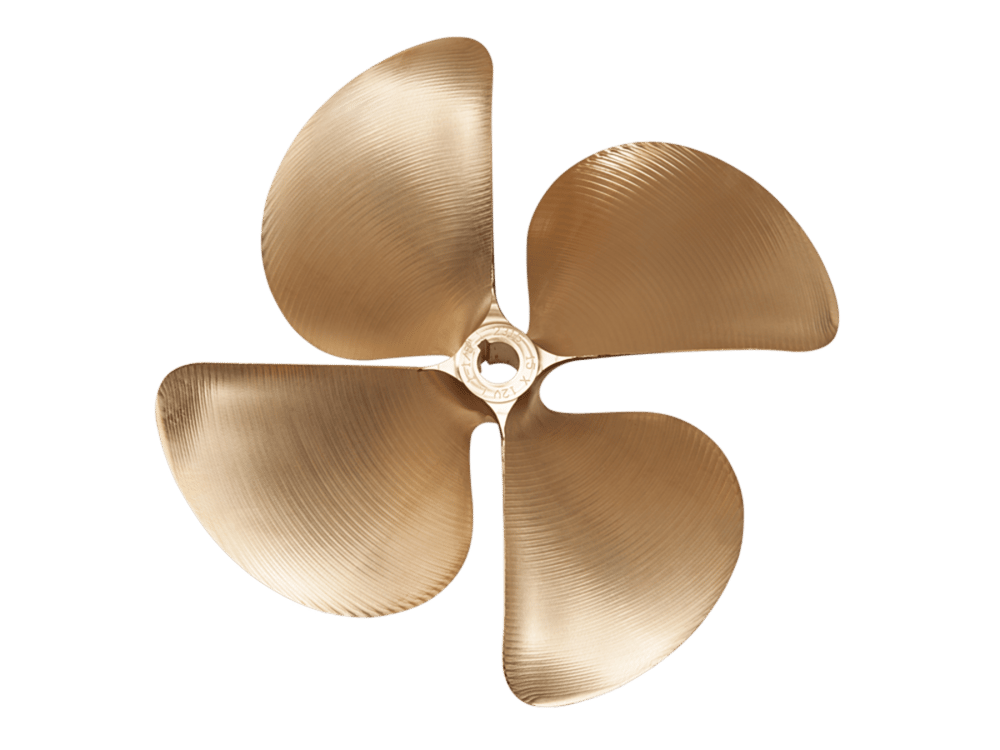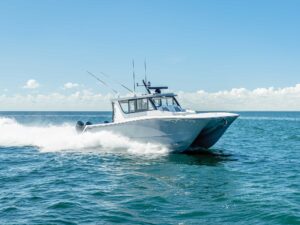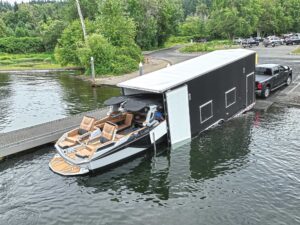
Rick Shadduck has never seen a boat he couldn’t prop. He’s so good at it, his co-workers say, he can usually pinpoint the correct prop for any new model on the first try. He seldom needs more than a second test run. Shadduck is the technical specialist for Cobalt Boats and has been water-testing its production models since 1989.
Shadduck says the key to getting maximum performance and long life from an engine is to use the prop that lets you get the full rpm range specified for the engine.
“If you’re running low in rpm, you’re running low in horsepower, and the engine won’t perform,” Shadduck says. “It will hurt acceleration and speed. When I test new boats, I usually have a light load, so I choose the propeller that lets the engine run right at the rev limiter. That way, when you load it the way you plan to boat, the engine is right at the specified wide-open throttle rpm.”
He was prepping a new Cobalt 243 with a Bravo Three propset. He’d just run a 22-inch pitch and didn’t like the high number of revolutions per minute. A 26-inch prop would have lugged the engine down — something that can damage it over time. By putting a 24-inch propset on, the 8.2- liter MerCruiser was able to reach its maximum specified rpm at wide-open throttle (WOT) without over-revving the engine or holding it back from attaining proper rpm.
Sometimes for boaters it’s the other way around. Even Shadduck misses one on the first try now and then.
“If an engine is constantly hitting the rev limiter with a 22-inch pitch, I know I need to bring down the rpm,” he says. And he knows just how to do it. “I’ll go from a 22- to a 24-inch prop, and that drops about 200 rpm.”
What about four-blade props? Shadduck thinks there are a lot of misconceptions about them.
“I’m not a fan,” he says. “They can be helpful on a boat that cavitates or blows out, but they rob you of speed and acceleration.” Still, Shadduck finds reasons to break his own rules. He uses them in special cases — like on his own boat, a heavy rig with a 26-degree deadrise bottom. On it he runs a 24-inch pitch four-blade prop to get more lift on plane.
“We have a 343 that runs better with a four-blade prop,” he says. “It’s heavy, and a four-blade prop helps it.”
If you find Shadduck’s opinion about four-blade props surprising, listen to his philosophy on choosing a Bravo Three drive over an alpha or Bravo One.
“A boat doesn’t usually benefit from a dual-prop drive until it exceeds 3,500 or 4,000 pounds,” he says. “Same goes for deeper-v boats. There’s less lift on a 24-degree bottom. You sacrifice speed for the ride, and a dual-prop drive will help compensate for less lift.”
When he does work with Bravo Threes, Shadduck has a preference for the lower-end, satin-finish props over Mercury’s polished Bravo Three X upgrades — at least in the recreational boat world.
“I don’t see much benefit from a polished prop over the satin finish,” he says. But there is another advantage to the Three X series that Shadduck taps now and then. “Sometimes I find a boat that needs a 23-inch pitch propset. The satin props come only in even numbers. I can get the Three X’s in 1-inch increments.” That allows better fine-tuning of the rpm range.
Shadduck also sees too many people unnecessarily choosing the more expensive stainless-steel props over aluminum.
“Stainless-steel props of the same size and dimension can perform better in most cases,” Shadduck says, “but if you’re a guy who boats in unknown waters or a lake that is shallow and rocky, you’d be better off running with an aluminum prop.”
Pardon me? Shadduck stands firm.
“If you run a stainless, you’ll get a little better performance, but it won’t give. If you hit rocks with an aluminum prop, you’ll tear up the prop, but it won’t wreck your drive,” he explains.
High altitude is another variable in the mix. Shadduck says Cobalt has handled it two ways. “We had some boats at a lake at 6,000 feet in Mexico,” he says. “We had to drop down in prop pitch because of less engine efficiency due to the thinner air. But if we have a boat we know is going to stay on Tahoe, for example, we’ll build it with a lower gear ratio and stay with the larger prop.
“Weather matters too,” he continues. “An engine runs better in cool, dry air than in hot, humid air, and that can affect prop size choice.”
Just when you think the mystery is solved.
Prop Talk
Pitch: The theoretical distance a prop will travel through water in one revolution.
Slip: The difference between the theoretical distance and the actual distance a prop moves through water in one revolution.
Rake: The degree of slant of the blades forward or aft of the hub. Choosing a prop with blades raked aft can increase lift, raising top speed.
Diameter: The distance across the circle scribed by the prop blades in rotation. A larger diameter can increase midrange power but will create more drag.
Cup: A radius of curve at the trailing edge of the blade. cup is often used to reduce ventilation.
Ventilation: Often confused with cavitation, it is the drawing of surface air into the propeller, causing loss of propulsion.
Cavitation: Vaporization of water due to suction in front of the propeller blade.









